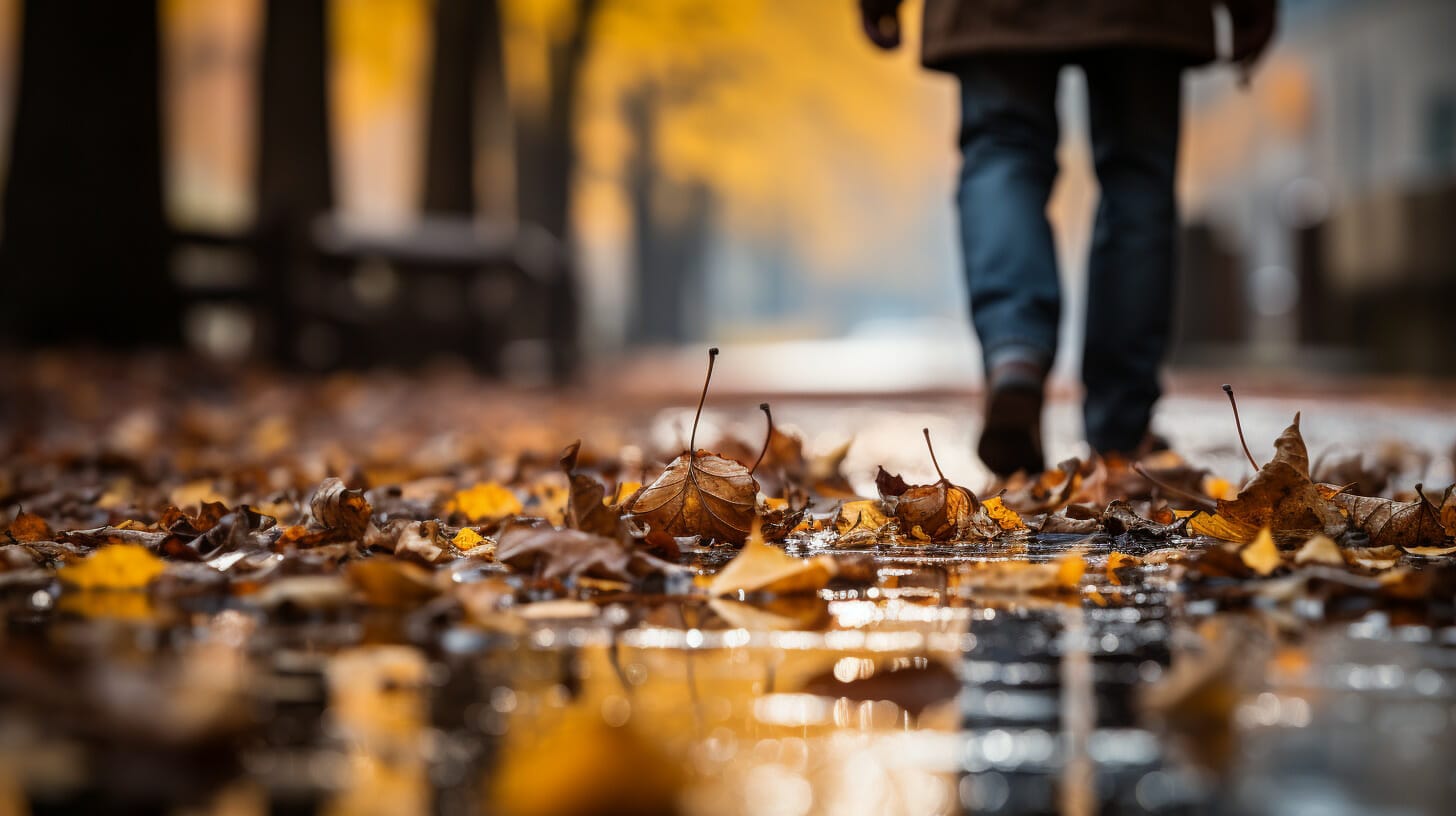As the leaves fall and seasons change, the risk of falls among the elderly population rises. This article provides comprehensive guidelines to ensure the safety of our elderly loved ones during the autumn season.
We explore home safety measures, the importance of physical fitness, appropriate footwear, regular health checks, nutritional advice, safe mobility techniques, and the role of medications in fall prevention.
Our aim is to equip you with knowledge to keep your aging family members safe and secure.
Understanding the Risks of Falls in the Elderly During Autumn
Frequently, the autumn season poses increased risks of falls for the elderly due to various environmental factors such as wet leaves and early darkness. Fall statistics indicate a significant increase in incidents during this period. The damp weather conditions can create slippery surfaces, making the elderly more susceptible to falls.
Moreover, the shortened daylight hours can further reduce visibility, creating hazardous conditions. Fall-related injuries amongst the elderly are not only common but can also lead to serious health complications. These include fractures, head injuries, and in severe cases, can even lead to loss of independence.
It is therefore crucial to understand these risks and take preventative measures to ensure the safety of elderly individuals during the autumn season.
Essential Home Safety Measures for Fall Prevention
In addition to understanding the risks, it is equally important to take proactive steps in implementing essential home safety measures for fall prevention. This can significantly reduce the likelihood of accidents among the elderly.
One important aspect of fall prevention is understanding environmental hazards and making the necessary home modifications. Key areas to focus on include stairs and floors, the bathroom, bedroom, kitchen, and outdoor areas.
To prevent falls on stairs and floors, installing secure handrails and using good lighting are crucial. It is also important to keep walking areas tidy, with no loose rugs or clutter that can cause tripping.
In the bathroom, safety can be enhanced by mounting grab bars near the toilet and in the shower or bath. Using nonskid mats on the floor can also help prevent slips and falls.
In the bedroom and kitchen, it is important to keep frequently used items within easy reach. This can help minimize the need for reaching or stretching, which can increase the risk of falls.
Outdoor safety involves ensuring that steps and walkways are in good condition and clear of debris. Regular maintenance and repair of outdoor areas can help prevent accidents caused by uneven surfaces or obstacles.
The Role of Physical Fitness in Preventing Falls
Physical fitness plays a critical role in preventing falls among the elderly. This involves targeted exercises to improve balance and strength training tailored to the needs of older individuals.
The subsequent discussion will explore these strategies in more detail, providing actionable tips for enhancing physical fitness and, consequently, reducing the risk of falls.
Fitness Exercises for Balance
A significant number of falls in the elderly population can be prevented through regular participation in fitness exercises specifically designed to enhance balance and stability.
Balance games serve as an engaging and fun way to improve coordination and stability, thereby reducing the risk of falls. These games can be as simple as standing on one foot or walking heel to toe, activities that can be done anywhere and do not require any special equipment.
Additionally, the yoga benefits for the elderly cannot be overstated. Yoga improves flexibility, strength, and balance—all critical factors in fall prevention. Regular practice of yoga can also boost confidence in movement, providing another layer of protection against falls.
Building Elderly Strength Training
Beyond improving balance, engaging in strength training exercises is crucial for elderly individuals, as it enhances their physical stability and significantly reduces the risk of falls.
Utilizing tools such as resistance bands can aid in low-impact strength training, which is a safe and effective method for seniors. Resistance bands usage promotes muscle strength and tone, therefore increasing stability and reducing fall risk.
Additionally, incorporating senior yoga into a fitness regimen offers multiple benefits. Yoga enhances flexibility, encourages mindfulness, and improves overall strength. The combination of resistance bands and yoga can significantly bolster physical fitness for elderly individuals.
Hence, building elderly strength training should be an integral part of fall prevention strategies to ensure safety and wellbeing this season.
Appropriate Footwear for Elderly in Fall Season
Choosing the right footwear plays a critical role in preventing falls among the elderly during the fall season. It is essential to consider both comfort and safety when selecting seasonal socks and slippers for the elderly.
- Seasonal Socks: Choose socks with non-slip grips on the bottom. They provide traction and can prevent slipping on smooth surfaces.
- Slipper Safety: Opt for slippers with a non-skid bottom and a secure fit. Oversized slippers can cause tripping.
- Proper Fit: Ensure shoes and slippers fit well and aren’t too loose or tight. Ill-fitting footwear can lead to instability.
- Sole Material: Look for rubber or other non-slip materials for added grip.
Importance of Regular Vision and Hearing Checks in Fall Prevention
We cannot underestimate the role of regular vision and hearing checks in preventing falls among the elderly, especially during the fall season. The importance of these checkups lies in their ability to identify any decline in sensory health.
Poor vision can make it difficult for seniors to see obstacles in their path, while impaired hearing can prevent them from recognizing important audio cues that could alert them of potential dangers. Regular vision and hearing checks can help detect these issues early on, allowing for intervention and treatment.
This proactive approach to sensory health significantly reduces the risk of falls. Therefore, ensuring regular checkups is an integral part of any fall prevention strategy for the elderly.
Nutritional Strategies for Strengthening Bones and Muscles
Proper nutrition plays a critical role in maintaining strength and stability, and it can significantly improve the health of both bones and muscles in elderly individuals. As part of a comprehensive fall prevention strategy, nutritional interventions should be considered.
- Increase Calcium Intake: This mineral is essential for bone health. Dairy products, leafy greens, and fortified foods are good sources.
- Vitamin D: It facilitates calcium absorption. Sun exposure and certain foods like fatty fish can provide this vitamin, but dietary supplements might be necessary for some.
- Protein-Rich Foods: Adequate protein consumption supports muscle maintenance and growth. Lean meats, dairy, and plant-based sources like lentils are recommended.
- Hydration: Dehydration can affect muscle function. Encourage regular fluid intake, especially water.
Nutrition is a powerful tool in promoting elderly safety this season.
Techniques for Safe Mobility on Wet or Leaf-covered Surfaces
Navigating through wet or leaf-covered surfaces can be challenging for the elderly, and it is crucial to understand safe mobility techniques to prevent falls during this season. Fall related injuries are a major concern, particularly in slippery conditions.
One technique is to use footwear with non-slip soles, providing necessary traction. Also, using assistive devices like canes or walkers can provide additional stability.
Visibility is paramount, so ensuring well-lit pathways is essential. Moreover, emergency preparedness is vital. Elderly individuals should carry a mobile device or a personal emergency response system to alert help if necessary.
The Influence of Medications on Fall Risks
You may not realize it, but certain medications can significantly increase the risk of falls among the elderly population. Proper medication management is crucial in fall prevention strategies.
- Anti-hypertensive medications: These can cause orthostatic hypotension, resulting in dizziness and potential falls when standing up.
- Central nervous system suppressants: Drugs like anti-anxiety medicine, older antihistamines, and prescription sleep aids reduce alertness, increasing fall risks.
- Overactive bladder prescriptions: These can slow reactions, leading to increased fall risks.
- Narcotics (opioids): These medications can cause drowsiness and slow movement, contributing to falls.
Identifying these medications and understanding their influence on balance and mobility can significantly aid in fall prevention among our elderly population.
Frequently Asked Questions
What Are Some Recommended Exercises for the Elderly to Improve Balance and Prevent Falls?
Recommended exercises for elderly individuals to improve balance include Tai Chi, yoga, and strength training. Alongside this, a balanced diet is crucial. Also, understanding the impact of medications on balance is essential for fall prevention.
Are There Any Fall Prevention Devices or Aids That Can Be Used by the Elderly During the Fall Season?
Yes, there are several fall prevention devices such as Fall Alarm Systems that alert caregivers during an event of a fall. Home Modifications like handrails and non-slip flooring can also greatly enhance safety for the elderly.
How Can Caregivers or Family Members Best Support Their Elderly Loved Ones in Fall Prevention?
Family members and caregivers can best support elderly loved ones in fall prevention through home modifications, such as installing grab bars, and medication management to ensure proper dosage and prevent dizziness or confusion.
Are There Particular Signs or Symptoms to Look Out for That May Indicate an Increased Risk of Falling in the Elderly?
Yes, certain signs can indicate an increased fall risk in seniors. Fall triggers include gait changes, frequent stumbling, or difficulty standing. Vision impairment, such as trouble adjusting to light, can also increase fall risk.
What Steps Should Be Taken if an Elderly Person Does Fall? What Kind of Medical Attention May Be Necessary?
If an elderly person falls, immediately execute the Emergency Response Plan, involving prompt medical evaluation. Medical Alert Systems can summon help swiftly. Medical attention may include assessment for fractures, head injuries, or other trauma.
Conclusion
In a twist of irony, the colorful allure of fall belies the potential hazards it poses to the elderly. Thus, vigilance in implementing home safety measures, ensuring physical fitness, choosing suitable footwear, conducting regular vision and hearing checks, adopting nutritional strategies for muscle and bone strength, mastering safe mobility techniques, and considering the impact of medications, are vital.
This multifaceted approach to fall prevention in the elderly ensures the beauty of autumn can be appreciated without the fear of falls.






